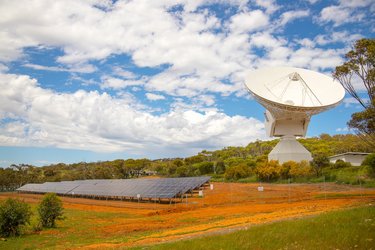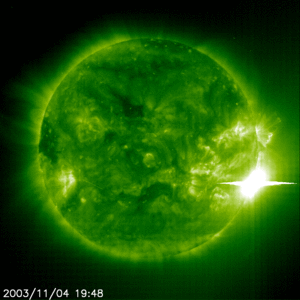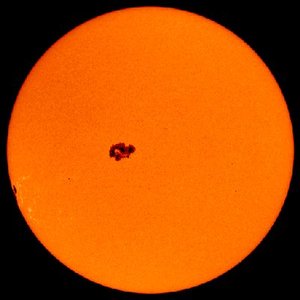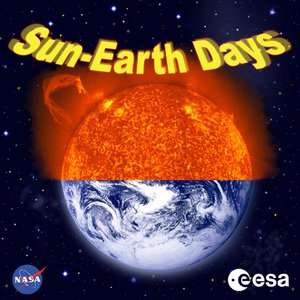Another giant solar explosion follows Tuesday’s enormous solar flare
ESA PR 71-2003. Since Tuesday 28 October, explosive events originating from the Sun have been bathing the Earth and its surroundings in high energy radiation.
Although 150 million kilometres away, the Sun is still capable of causing major disruption here on Earth to a range of systems that we depend on in everyday life. These include communication and navigation systems, aircraft and spacecraft operations and the distribution of electricity at high latitudes.
The activity started on Tuesday with a giant solar flare - the second biggest ever seen by SOHO, the ESA-NASA solar observatory that maintains a constant watch on the Sun, monitoring these events as they happen. A few minutes later, spacecraft circling the Earth began to detect high levels of energetic radiation, capable of blinding satellites and causing increased radiation levels down to normal aircraft cruising altitudes. About 24 hours after the solar flare was observed, an accompanying coronal mass ejection - a giant cloud of magnetised plasma - reached the Earth, causing rapid changes in the Earth's magnetic field and what is known as a geomagnetic storm. This storm caused widespread disruption to communications; both satellite-based and HF radio.
These events are truly sporadic and extremely difficult to predict. On Wednesday it appeared that radiation levels were decreasing. However, a second flare overnight has caused a further sharp increase in radiation levels. Here on Earth, the disruption continues today with a further coronal mass ejection expected to reach the Earth tomorrow in time for Halloween.
Solar eruptions of this type together with the associated increased radiation levels and electromagnetic disturbances around the Earth have real immediate and long-term economic impacts. During the last few days, space weather related problems have been detected on spacecraft operated by a range of agencies across the globe and operations teams are on alert. On Earth, telecommunication links have been disrupted and steps have been taken to safeguard aircraft, which including some changes in scheduling. Effects have also been detected in high latitude power grids and are being carefully monitored.
The increased dependency of our society on systems which are directly or indirectly influenced by solar and other events seen in space raises concerns about our ability to monitor and anticipate these events and the resulting changes collectively referred to as space weather. At the European Space Agency these issues are being handled jointly in the Electromagnetics and Space Environment Division by Dr Eamonn Daly’s group for the specifications of spacecraft protection and in the spacecraft operations teams.
In addition, Europe-wide coordination is currently being set up together with the European Union via its COST (Coordination in Science and Technology) programme and ESA’s General Studies Programme. This coordination aims to optimise our existing resources (together with our international partners) in order to develop an operational resource which will enable society to respond effectively to immediate as well as long-term changes in our space weather.
For further information, please contact :
ESA Media Relations Service
Tel: +33(0)1.53.69.7155
Fax: +33(0)1.53.69.7690















 Germany
Germany
 Austria
Austria
 Belgium
Belgium
 Denmark
Denmark
 Spain
Spain
 Estonia
Estonia
 Finland
Finland
 France
France
 Greece
Greece
 Hungary
Hungary
 Ireland
Ireland
 Italy
Italy
 Luxembourg
Luxembourg
 Norway
Norway
 The Netherlands
The Netherlands
 Poland
Poland
 Portugal
Portugal
 Czechia
Czechia
 Romania
Romania
 United Kingdom
United Kingdom
 Sweden
Sweden
 Switzerland
Switzerland































